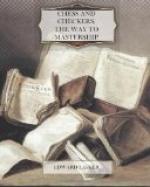This is the main point. A second move made with a piece must improve its position, otherwise, common sense tells us, it is surely bad. For instance: After (1) P-e4, P-e5; (2) Kt-f3, Kt-c6; (3) B-b5, Kt-f6; (4) o-o, B-e7 there is no objection to White’s playing (5) R-e1 as the Rook will very likely want to get into action in the e-file in any case, as soon as the development has progressed with P-d4, Kt-c3, B-g5, etc.
But if in an opening like (1) P-e4, P-e5; (2) Kt-f3, Kt-c6; (3) B-c4, Kt-f6 White plays (4) Kt-g5 for instance, or (4) B-d5, it is evident that he merely wastes time, for in the first case he places the Knight on a square from which he is sure to be driven away again as soon as the direct attack involved in his move has been warded off, and in the second case he moves the Bishop to a square which does not afford him any more mobility than the one on which he stood before.
As a rule only Rooks or Knights are in a position, during the opening, to add to their mobility by a second move; the Rooks by occupying a file which is liable to be opened by an exchange of Pawns, and the Knights by occupying a square in the center of the board.
The Knights are really more often under the necessity of making several moves in succession than any other piece, because they can never pass over more than one line at a time, and they may be required to hasten from one wing of the board to the other just as often as the other pieces. This is the reason why the most favorable spot for a Knight is a square in the center of the board; there he is always ready for an excursion to either wing.
The establishment of a Knight in the center can more readily be effected in Queen’s Pawn openings than in King’s Pawn openings. This will be evident from the following consideration:
In Queen’s Pawn openings the squares e5 and e4 are the ones which are aimed at by the respective Knights. If the opponent exchanges the Knight with either his Queen’s Knight or his King’s Bishop, the Pawn which takes the place of the Knight in recapturing, gains control of two squares in the heart of the hostile camp. To illustrate this by a case which often occurs: If after (1) P-d4, P-d5; (2) Kt-f3, Kt-f6; (3) P-e3, P-c5; (4) B-d3, Kt-c6; (5) o-o, P-e6; (6) P-b3, B-d6; (7) B-b2, o-o; (8) Ktb1-d2, P-b6; (9) Kt-e5 Black plays Bxe5, White in retaking drives Black’s King’s Knight away depriving the King’s wing of an important protection and also creating a weakness on d6, where White might be able at some later stage of the game to establish his Knight.
+---------------------------------------+ 8 | #R | | #B | #Q | | #R | #K | | |---------------------------------------| 7 | #P | | | | | #P | #P | #P | |---------------------------------------| 6 | | #P | #Kt| #B | #P | #Kt| | | |---------------------------------------| 5 | | | #P | #P | ^Kt| | | | |---------------------------------------|




